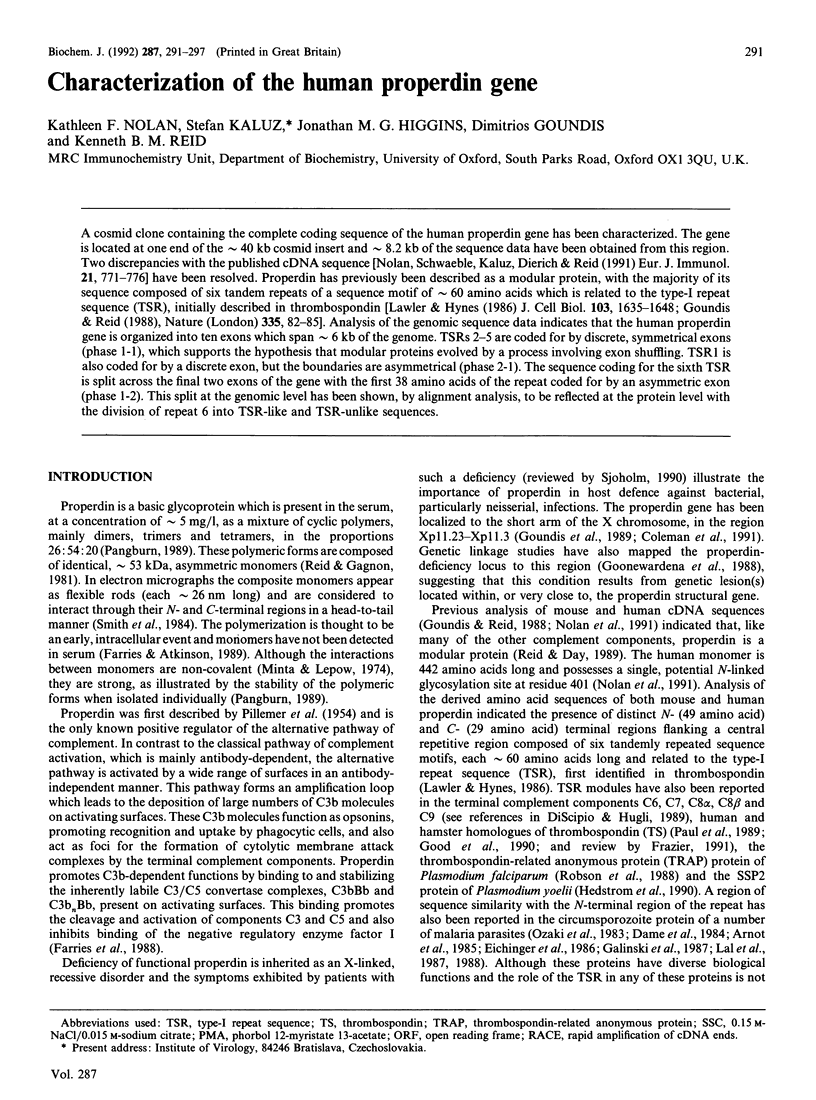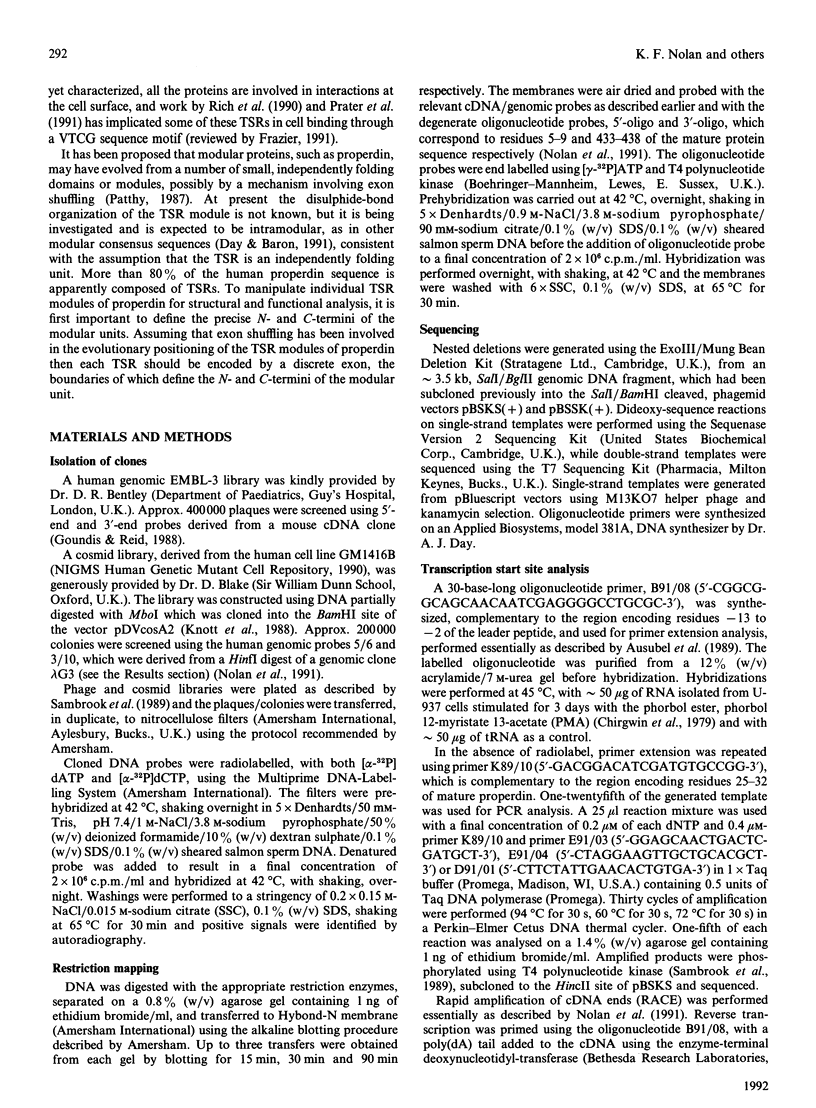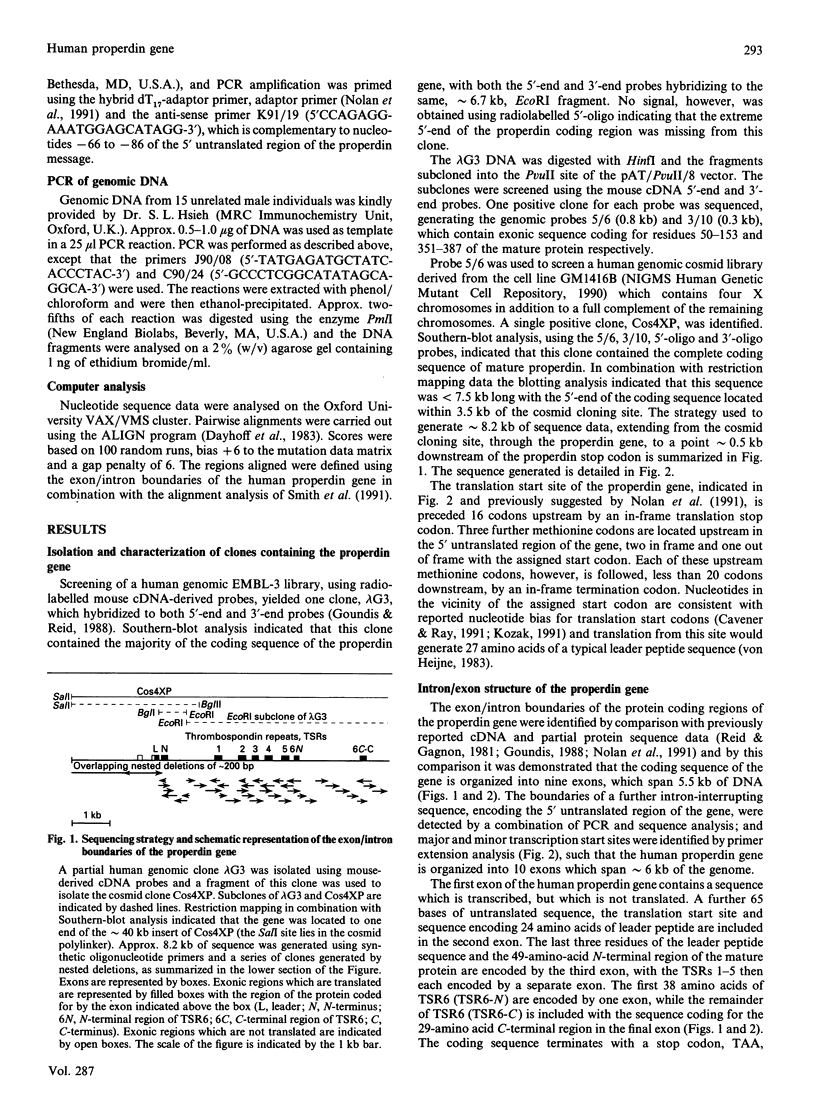Abstract
A cosmid clone containing the complete coding sequence of the human properdin gene has been characterized. The gene is located at one end of the approximately 40 kb cosmid insert and approximately 8.2 kb of the sequence data have been obtained from this region. Two discrepancies with the published cDNA sequence [Nolan, Schwaeble, Kaluz, Dierich & Reid (1991) Eur. J. Immunol. 21, 771-776] have been resolved. Properdin has previously been described as a modular protein, with the majority of its sequence composed of six tandem repeats of a sequence motif of approximately 60 amino acids which is related to the type-I repeat sequence (TSR), initially described in thrombospondin [Lawler & Hynes (1986) J. Cell Biol. 103, 1635-1648; Goundis & Reid (1988), Nature (London) 335, 82-85]. Analysis of the genomic sequence data indicates that the human properdin gene is organized into ten exons which span approximately 6 kb of the genome. TSRs 2-5 are coded for by discrete, symmetrical exons (phase 1-1), which supports the hypothesis that modular proteins evolved by a process involving exon shuffling. TSR1 is also coded for by a discrete exon, but the boundaries are asymmetrical (phase 2-1). The sequence coding for the sixth TSR is split across the final two exons of the gene with the first 38 amino acids of the repeat coded for by an asymmetric exon (phase 1-2). This split at the genomic level has been shown, by alignment analysis, to be reflected at the protein level with the division of repeat 6 into TSR-like and TSR-unlike sequences.
Full text
PDF






Selected References
These references are in PubMed. This may not be the complete list of references from this article.
- Arnot D. E., Barnwell J. W., Tam J. P., Nussenzweig V., Nussenzweig R. S., Enea V. Circumsporozoite protein of Plasmodium vivax: gene cloning and characterization of the immunodominant epitope. Science. 1985 Nov 15;230(4727):815–818. doi: 10.1126/science.2414847. [DOI] [PubMed] [Google Scholar]
- Baron M., Norman D. G., Campbell I. D. Protein modules. Trends Biochem Sci. 1991 Jan;16(1):13–17. doi: 10.1016/0968-0004(91)90009-k. [DOI] [PubMed] [Google Scholar]
- Bornstein P., Alfi D., Devarayalu S., Framson P., Li P. Characterization of the mouse thrombospondin gene and evaluation of the role of the first intron in human gene expression. J Biol Chem. 1990 Sep 25;265(27):16691–16698. [PubMed] [Google Scholar]
- Bornstein P., Devarayalu S., Li P., Disteche C. M., Framson P. A second thrombospondin gene in the mouse is similar in organization to thrombospondin 1 but does not respond to serum. Proc Natl Acad Sci U S A. 1991 Oct 1;88(19):8636–8640. doi: 10.1073/pnas.88.19.8636. [DOI] [PMC free article] [PubMed] [Google Scholar]
- Cavener D. R., Ray S. C. Eukaryotic start and stop translation sites. Nucleic Acids Res. 1991 Jun 25;19(12):3185–3192. doi: 10.1093/nar/19.12.3185. [DOI] [PMC free article] [PubMed] [Google Scholar]
- Chirgwin J. M., Przybyla A. E., MacDonald R. J., Rutter W. J. Isolation of biologically active ribonucleic acid from sources enriched in ribonuclease. Biochemistry. 1979 Nov 27;18(24):5294–5299. doi: 10.1021/bi00591a005. [DOI] [PubMed] [Google Scholar]
- Coleman M. P., Murray J. C., Willard H. F., Nolan K. F., Reid K. B., Blake D. J., Lindsay S., Bhattacharya S. S., Wright A., Davies K. E. Genetic and physical mapping around the properdin P gene. Genomics. 1991 Dec;11(4):991–996. doi: 10.1016/0888-7543(91)90024-9. [DOI] [PubMed] [Google Scholar]
- Corden J., Wasylyk B., Buchwalder A., Sassone-Corsi P., Kedinger C., Chambon P. Promoter sequences of eukaryotic protein-coding genes. Science. 1980 Sep 19;209(4463):1406–1414. doi: 10.1126/science.6251548. [DOI] [PubMed] [Google Scholar]
- Dame J. B., Williams J. L., McCutchan T. F., Weber J. L., Wirtz R. A., Hockmeyer W. T., Maloy W. L., Haynes J. D., Schneider I., Roberts D. Structure of the gene encoding the immunodominant surface antigen on the sporozoite of the human malaria parasite Plasmodium falciparum. Science. 1984 Aug 10;225(4662):593–599. doi: 10.1126/science.6204383. [DOI] [PubMed] [Google Scholar]
- Dayhoff M. O., Barker W. C., Hunt L. T. Establishing homologies in protein sequences. Methods Enzymol. 1983;91:524–545. doi: 10.1016/s0076-6879(83)91049-2. [DOI] [PubMed] [Google Scholar]
- DiScipio R. G., Hugli T. E. The molecular architecture of human complement component C6. J Biol Chem. 1989 Sep 25;264(27):16197–16206. [PubMed] [Google Scholar]
- Eichinger D. J., Arnot D. E., Tam J. P., Nussenzweig V., Enea V. Circumsporozoite protein of Plasmodium berghei: gene cloning and identification of the immunodominant epitopes. Mol Cell Biol. 1986 Nov;6(11):3965–3972. doi: 10.1128/mcb.6.11.3965. [DOI] [PMC free article] [PubMed] [Google Scholar]
- Farries T. C., Atkinson J. P. Biosynthesis of properdin. J Immunol. 1989 Feb 1;142(3):842–847. [PubMed] [Google Scholar]
- Farries T. C., Lachmann P. J., Harrison R. A. Analysis of the interactions between properdin, the third component of complement (C3), and its physiological activation products. Biochem J. 1988 May 15;252(1):47–54. doi: 10.1042/bj2520047. [DOI] [PMC free article] [PubMed] [Google Scholar]
- Frazier W. A. Thrombospondins. Curr Opin Cell Biol. 1991 Oct;3(5):792–799. doi: 10.1016/0955-0674(91)90052-z. [DOI] [PubMed] [Google Scholar]
- Galinski M. R., Arnot D. E., Cochrane A. H., Barnwell J. W., Nussenzweig R. S., Enea V. The circumsporozoite gene of the Plasmodium cynomolgi complex. Cell. 1987 Jan 30;48(2):311–319. doi: 10.1016/0092-8674(87)90434-x. [DOI] [PubMed] [Google Scholar]
- Good D. J., Polverini P. J., Rastinejad F., Le Beau M. M., Lemons R. S., Frazier W. A., Bouck N. P. A tumor suppressor-dependent inhibitor of angiogenesis is immunologically and functionally indistinguishable from a fragment of thrombospondin. Proc Natl Acad Sci U S A. 1990 Sep;87(17):6624–6628. doi: 10.1073/pnas.87.17.6624. [DOI] [PMC free article] [PubMed] [Google Scholar]
- Goonewardena P., Sjöholm A. G., Nilsson L. A., Pettersson U. Linkage analysis of the properdin deficiency gene: suggestion of a locus in the proximal part of the short arm of the X chromosome. Genomics. 1988 Feb;2(2):115–118. doi: 10.1016/0888-7543(88)90092-4. [DOI] [PubMed] [Google Scholar]
- Goundis D., Holt S. M., Boyd Y., Reid K. B. Localization of the properdin structural locus to Xp11.23-Xp21.1. Genomics. 1989 Jul;5(1):56–60. doi: 10.1016/0888-7543(89)90085-2. [DOI] [PubMed] [Google Scholar]
- Goundis D., Reid K. B. Properdin, the terminal complement components, thrombospondin and the circumsporozoite protein of malaria parasites contain similar sequence motifs. Nature. 1988 Sep 1;335(6185):82–85. doi: 10.1038/335082a0. [DOI] [PubMed] [Google Scholar]
- Hedstrom R. C., Campbell J. R., Leef M. L., Charoenvit Y., Carter M., Sedegah M., Beaudoin R. L., Hoffman S. L. A malaria sporozoite surface antigen distinct from the circumsporozoite protein. Bull World Health Organ. 1990;68 (Suppl):152–157. [PMC free article] [PubMed] [Google Scholar]
- Jurka J., Smith T. A fundamental division in the Alu family of repeated sequences. Proc Natl Acad Sci U S A. 1988 Jul;85(13):4775–4778. doi: 10.1073/pnas.85.13.4775. [DOI] [PMC free article] [PubMed] [Google Scholar]
- Knott V., Rees D. J., Cheng Z., Brownlee G. G. Randomly picked cosmid clones overlap the pyrB and oriC gap in the physical map of the E. coli chromosome. Nucleic Acids Res. 1988 Mar 25;16(6):2601–2612. doi: 10.1093/nar/16.6.2601. [DOI] [PMC free article] [PubMed] [Google Scholar]
- Kozak M. An analysis of vertebrate mRNA sequences: intimations of translational control. J Cell Biol. 1991 Nov;115(4):887–903. doi: 10.1083/jcb.115.4.887. [DOI] [PMC free article] [PubMed] [Google Scholar]
- Kozak M. The scanning model for translation: an update. J Cell Biol. 1989 Feb;108(2):229–241. doi: 10.1083/jcb.108.2.229. [DOI] [PMC free article] [PubMed] [Google Scholar]
- Lal A. A., de la Cruz V. F., Collins W. E., Campbell G. H., Procell P. M., McCutchan T. F. Circumsporozoite protein gene from Plasmodium brasilianum. Animal reservoirs for human malaria parasites? J Biol Chem. 1988 Apr 25;263(12):5495–5498. [PubMed] [Google Scholar]
- Lal A. A., de la Cruz V. F., Welsh J. A., Charoenvit Y., Maloy W. L., McCutchan T. F. Structure of the gene encoding the circumsporozoite protein of Plasmodium yoelii. A rodent model for examining antimalarial sporozoite vaccines. J Biol Chem. 1987 Mar 5;262(7):2937–2940. [PubMed] [Google Scholar]
- Lawler J., Hynes R. O. The structure of human thrombospondin, an adhesive glycoprotein with multiple calcium-binding sites and homologies with several different proteins. J Cell Biol. 1986 Nov;103(5):1635–1648. doi: 10.1083/jcb.103.5.1635. [DOI] [PMC free article] [PubMed] [Google Scholar]
- Lehrman M. A., Russell D. W., Goldstein J. L., Brown M. S. Alu-Alu recombination deletes splice acceptor sites and produces secreted low density lipoprotein receptor in a subject with familial hypercholesterolemia. J Biol Chem. 1987 Mar 5;262(7):3354–3361. [PubMed] [Google Scholar]
- Marazziti D., Eggertsen G., Fey G. H., Stanley K. K. Relationships between the gene and protein structure in human complement component C9. Biochemistry. 1988 Aug 23;27(17):6529–6534. doi: 10.1021/bi00417a050. [DOI] [PubMed] [Google Scholar]
- Minta J. O., Lepow I. H. Studies on the sub-unit structure of human properdin. Immunochemistry. 1974 Jul;11(7):361–368. doi: 10.1016/0019-2791(74)90189-x. [DOI] [PubMed] [Google Scholar]
- Nolan K. F., Schwaeble W., Kaluz S., Dierich M. P., Reid K. B. Molecular cloning of the cDNA coding for properdin, a positive regulator of the alternative pathway of human complement. Eur J Immunol. 1991 Mar;21(3):771–776. doi: 10.1002/eji.1830210333. [DOI] [PubMed] [Google Scholar]
- Ozaki L. S., Svec P., Nussenzweig R. S., Nussenzweig V., Godson G. N. Structure of the plasmodium knowlesi gene coding for the circumsporozoite protein. Cell. 1983 Oct;34(3):815–822. doi: 10.1016/0092-8674(83)90538-x. [DOI] [PubMed] [Google Scholar]
- PILLEMER L., BLUM L., LEPOW I. H., ROSS O. A., TODD E. W., WARDLAW A. C. The properdin system and immunity. I. Demonstration and isolation of a new serum protein, properdin, and its role in immune phenomena. Science. 1954 Aug 20;120(3112):279–285. doi: 10.1126/science.120.3112.279. [DOI] [PubMed] [Google Scholar]
- Pangburn M. K. Analysis of the natural polymeric forms of human properdin and their functions in complement activation. J Immunol. 1989 Jan 1;142(1):202–207. [PubMed] [Google Scholar]
- Patthy L. Evolution of the proteases of blood coagulation and fibrinolysis by assembly from modules. Cell. 1985 Jul;41(3):657–663. doi: 10.1016/s0092-8674(85)80046-5. [DOI] [PubMed] [Google Scholar]
- Patthy L. Exons--original building blocks of proteins? Bioessays. 1991 Apr;13(4):187–192. doi: 10.1002/bies.950130408. [DOI] [PubMed] [Google Scholar]
- Patthy L. Intron-dependent evolution: preferred types of exons and introns. FEBS Lett. 1987 Apr 6;214(1):1–7. doi: 10.1016/0014-5793(87)80002-9. [DOI] [PubMed] [Google Scholar]
- Prater C. A., Plotkin J., Jaye D., Frazier W. A. The properdin-like type I repeats of human thrombospondin contain a cell attachment site. J Cell Biol. 1991 Mar;112(5):1031–1040. doi: 10.1083/jcb.112.5.1031. [DOI] [PMC free article] [PubMed] [Google Scholar]
- Proudfoot N. J., Brownlee G. G. 3' non-coding region sequences in eukaryotic messenger RNA. Nature. 1976 Sep 16;263(5574):211–214. doi: 10.1038/263211a0. [DOI] [PubMed] [Google Scholar]
- Reid K. B., Day A. J. Structure-function relationships of the complement components. Immunol Today. 1989 Jun;10(6):177–180. doi: 10.1016/0167-5699(89)90317-4. [DOI] [PubMed] [Google Scholar]
- Reid K. B., Gagnon J. Amino acid sequence studies of human properdin--N-terminal sequence analysis and alignment of the fragments produced by limited proteolysis with trypsin and the peptides produced by cyanogen bromide treatment. Mol Immunol. 1981 Nov;18(11):949–959. doi: 10.1016/0161-5890(81)90112-7. [DOI] [PubMed] [Google Scholar]
- Rich K. A., George F. W., 4th, Law J. L., Martin W. J. Cell-adhesive motif in region II of malarial circumsporozoite protein. Science. 1990 Sep 28;249(4976):1574–1577. doi: 10.1126/science.2120774. [DOI] [PubMed] [Google Scholar]
- Robson K. J., Hall J. R., Jennings M. W., Harris T. J., Marsh K., Newbold C. I., Tate V. E., Weatherall D. J. A highly conserved amino-acid sequence in thrombospondin, properdin and in proteins from sporozoites and blood stages of a human malaria parasite. Nature. 1988 Sep 1;335(6185):79–82. doi: 10.1038/335079a0. [DOI] [PubMed] [Google Scholar]
- Sjöholm A. G. Inherited complement deficiency states: implications for immunity and immunological disease. APMIS. 1990 Oct;98(10):861–874. doi: 10.1111/j.1699-0463.1990.tb05008.x. [DOI] [PubMed] [Google Scholar]
- Smith C. A., Pangburn M. K., Vogel C. W., Müller-Eberhard H. J. Molecular architecture of human properdin, a positive regulator of the alternative pathway of complement. J Biol Chem. 1984 Apr 10;259(7):4582–4588. [PubMed] [Google Scholar]
- Smith K. F., Nolan K. F., Reid K. B., Perkins S. J. Neutron and X-ray scattering studies on the human complement protein properdin provide an analysis of the thrombospondin repeat. Biochemistry. 1991 Aug 13;30(32):8000–8008. doi: 10.1021/bi00246a018. [DOI] [PubMed] [Google Scholar]
- Tosi M., Stoppa-Lyonnet D., Carter P., Meo T. Molecular defects of the C1-inhibitor gene in hereditary angioedema. Behring Inst Mitt. 1989 Jul;(84):173–179. [PubMed] [Google Scholar]
- Wolf F. W., Eddy R. L., Shows T. B., Dixit V. M. Structure and chromosomal localization of the human thrombospondin gene. Genomics. 1990 Apr;6(4):685–691. doi: 10.1016/0888-7543(90)90505-o. [DOI] [PubMed] [Google Scholar]
- von Heijne G. Patterns of amino acids near signal-sequence cleavage sites. Eur J Biochem. 1983 Jun 1;133(1):17–21. doi: 10.1111/j.1432-1033.1983.tb07424.x. [DOI] [PubMed] [Google Scholar]


